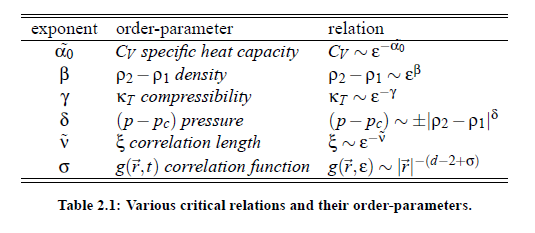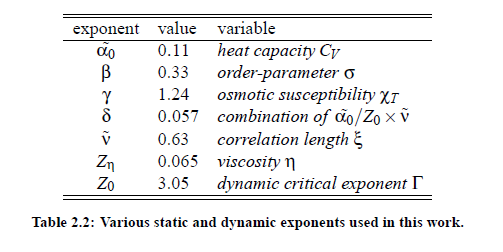2005-(II)-Critical Phenomena and Universality
The fascination about critical phenomena is based on the universality of the behaviour of systems, which can be quite different in many of their properties. Theoretical models of critical behavior are based on the terms renormalization and scaling. Such a new model shall be verified by comprehensive measurement of coupled parameters of critically segregating binary fluids. In addition, binary mixtures are to be investigated whose spectra reflect both universal and individual behaviour. Of particular interest is the coupling of critical dynamics to elementary chemical processes.
The similarity of different systems can be described by universal power laws which determine the thermodynamic and transport properties close to a critical point. In order to study the critical behavior in different systems it is convenient to use the so-called reduced temperature:
When the temperature T of a system is close to its critical temperature T , some relevant parameters F follow a power law:
with x > 0. At ε → 0, that is T → T , all terms except the 1 in the brackets disappear. Therefore, F satisfies the power law:
with ϕ, denoting the critical exponent for the particular variable F.
Static scaling hypothesis:
In the course of the last fifty years theoretical and experimental investigations have been done to develop and to proof the hypothesis of universality. In 1965 Widom postulated the so-called scaling hypothesis, which is based on the assumption, that the singularities of different thermodynamic quantities near the critical point are represented by their generalized homogenous functions. When F denotes the free energy and ε the reduced temperature, it follows:
It means, when the parameter λ scales the reduced temperature ε, than λ likewise scales the function of ε. Furthermore, if µ is an additional scaled variable of the function g, than:
Comparison of the factors of the function of F (ε) implies that the relation g (λ)g (µ) = g (λµ) is only valid when g follows a power law. Hence:
From such mathematical considerations follows that differentials as well as integrals of homogenous functions are again homogenous functions. Consequently, it can be assumed that all thermodynamical quantities, which are derived from the free energy F , can be represented by power laws. Furthermore, the static scaling hypothesis provides also relations between the critical exponents of different parameters (see Table (2.1), for the meaning of the symbols):
In 1971 the renormalization group method has been developed by Wilson [ 15] to calculate the critical exponents. This theory showed that the critical exponents depend only on the spacial dimensionality d and the number n of components of a system. Moreover, the essential message of those considerations was that phase transitions with the same dimensionality of the order parameter belong to the same universality class. Various critical exponents of systems and their order-parameter are represented in Table (2.1).
Dynamic scaling hypothesis and critical slowing down:
In different investigations it has been found that, close to the critical point, various properties of relevant systems follow power laws, so that their thermodynamic properties diverge or vanish at the critical point. According to the above connsiderations, the static scaling hypothesis takes into account the growing of characteristic length of a system near the critical point. However, another important observation is that all transport phenomena undergo a slowing down, caused by the increase of the correlation length ξ. Consequently,it can be assumed that, in addition to the characteristic length, there exists a characteristic time scale. The dynamic scaling hypothesis, which describes the phenomenon of so-called critical slowing down, was first introduced by Ferrell in 1967 and was subsequently generalized for magnetic systems by Halperin and Hohenberg (1969). The hypothesis implies that, when the temperature T of a system approaches the critical temperature T, the relaxation time τ is governed by ξ . Here v˜ is the exponent c ξ of the fluctuation correlation length, Table (2.2). With the life time of fluctuations, given by 1/τξ = Γ, and using generalized homogenous functions it is possible to to express Γ as a generalized homogenous function of the wave vector q and the reciprocal correlation length of the critical fluctuations ξ−1:
ere is z the degree of homogeneity. With the assumption λ = q−1 and the implementation of the relation Ω(qξ) = f (1, (qξ)−1) it is possible to scale the relaxation rate Γ:
The function Ω(qξ) is the so-called dynamic scaling function of the variables q and ξ. This function plays an important role in the treatment of critical dynamic phenomena. Within the scope of renormalization group theory of critical phenomena it is possible to calculate specific values of the critical exponents. The results of these calculations, which have been done by Gillou for static critical exponents and Burstyn and Sengers for dynamic critical exponents, are shown in Table (2.2). The development of dynamic scaling theories is a continuous process and undergoes permanent corrections and improvements










